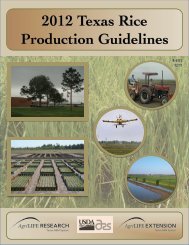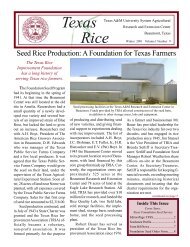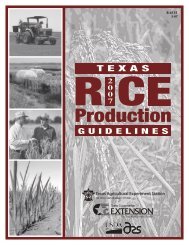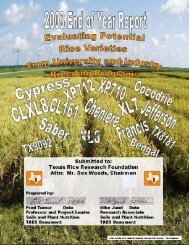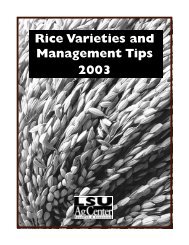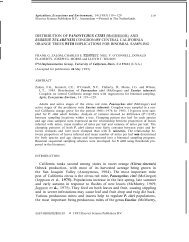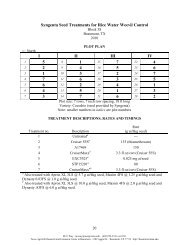Texas Rice - Texas A&M AgriLIFE Research Center at Beaumont ...
Texas Rice - Texas A&M AgriLIFE Research Center at Beaumont ...
Texas Rice - Texas A&M AgriLIFE Research Center at Beaumont ...
Create successful ePaper yourself
Turn your PDF publications into a flip-book with our unique Google optimized e-Paper software.
Arkansas Farmer, Scientist Win N<strong>at</strong>ional<br />
Conserv<strong>at</strong>ion Tillage Awards<br />
A Poinsett County farmer and a<br />
University of Arkansas Division of<br />
Agriculture scientist received the<br />
<strong>Rice</strong> Farmer of the Year and <strong>Rice</strong><br />
<strong>Research</strong>er of the Year awards <strong>at</strong> the<br />
N<strong>at</strong>ional Conserv<strong>at</strong>ion Tillage Cotton<br />
and <strong>Rice</strong> Conference Jan. 13-14<br />
in Houston.<br />
The awards were presented to<br />
Scott M<strong>at</strong>thews of Weiner and Dr.<br />
Merle Anders, Assistant Professor of<br />
crop, soil, and environmental sciences,<br />
based <strong>at</strong> the Division of<br />
Agriculture’s <strong>Rice</strong> <strong>Research</strong> and Extension<br />
<strong>Center</strong> near Stuttgart. The<br />
annual conference provides a forum<br />
for researchers, crop consultants and farmers to share<br />
inform<strong>at</strong>ion about conserv<strong>at</strong>ion tillage.<br />
Anders has been conducting a long-term rot<strong>at</strong>ion<br />
study since 2000, comparing conventional tillage and<br />
no-till systems in rice, soybeans, corn and whe<strong>at</strong> in<br />
collabor<strong>at</strong>ion with other scientists and organiz<strong>at</strong>ions.<br />
“We see a significant reduction in runoff of soil<br />
and phosphorus from the no-till tre<strong>at</strong>ments,” Anders<br />
said. He also cited benefits such as:<br />
• less clay-pan resistance to root penetr<strong>at</strong>ion,<br />
which helps soybeans th<strong>at</strong> follow the rice crop;<br />
• no soil crusting after heavy rain, which saves<br />
w<strong>at</strong>er normally used to flush a field when soil is crusted<br />
over before seedlings emerge; and<br />
• increased organic nitrogen uptake, which suggests<br />
the potential to reduce nitrogen inputs.<br />
No-till systems are widely used in cotton and soybeans,<br />
but have been slow to c<strong>at</strong>ch on in rice, Anders<br />
said. M<strong>at</strong>thews said he uses no-till exclusively, when<br />
possible, on his 1,150 acres, which are all in a rice and<br />
soybean crop rot<strong>at</strong>ion.<br />
“The bottom line is th<strong>at</strong> no-till saves time, labor,<br />
equipment repairs, fuel and w<strong>at</strong>er,” M<strong>at</strong>thews said.<br />
“Early is wh<strong>at</strong> makes it go for me,” M<strong>at</strong>thews said. “I<br />
am very aggressive in using new, earlier varieties and<br />
other technology.”<br />
By early planting of varieties th<strong>at</strong> m<strong>at</strong>ure early,<br />
M<strong>at</strong>thews hopes each year to harvest beans and rice<br />
before fall rains begin. Combines in wet fields cause<br />
Dr. Merle Anders shows stubble in a no-till rice research plot. He has found th<strong>at</strong><br />
reduced tillage to prepare the seedbed makes the clay pan under the topsoil less resistant<br />
to root penetr<strong>at</strong>ion by soybeans th<strong>at</strong> are often planted in rot<strong>at</strong>ion with rice.<br />
6<br />
rutting, which often requires using tillage equipment<br />
to prepare the seedbed for the next planting.<br />
M<strong>at</strong>thews sometimes has to work rutted fields in<br />
the fall, but, he said, “I don’t remember the last time I<br />
worked a field in the spring.”<br />
Conserv<strong>at</strong>ion tillage encompasses the three levels<br />
of minimum-till, which includes using equipment for<br />
minimal prepar<strong>at</strong>ion of a seedbed in the spring; contill,<br />
which involves working land after harvest but not<br />
in the spring; and no-till. “No-till works the best for<br />
me,” M<strong>at</strong>thews said, “but every farmer should m<strong>at</strong>ch<br />
the system to his ground.” Keeping tillage equipment<br />
parked allows major savings in fuel, labor and repairs,<br />
he said. M<strong>at</strong>thews said he is very pleased with the<br />
yields from his no-till system, especially in soybeans.<br />
And he has reduced w<strong>at</strong>ering of his soybeans, which<br />
are all irrig<strong>at</strong>ed, from three or four using conventional<br />
tillage to one or two with no-till.<br />
M<strong>at</strong>thews’ advice for other farmers who want to<br />
try a conserv<strong>at</strong>ion tillage system is to m<strong>at</strong>ch the system<br />
to their soils, and, “I would stress, use the new<br />
technology.” He said he is looking into precision systems<br />
th<strong>at</strong> use Global Positioning System (GPS) technology<br />
as the next innov<strong>at</strong>ion in his oper<strong>at</strong>ion.<br />
For more inform<strong>at</strong>ion contact Merle Anders, Arkansas<br />
<strong>Rice</strong> <strong>Research</strong> & Extension <strong>Center</strong>, 870-673-<br />
2661. *<br />
Excerpted from an article by Howell Medders,<br />
UARK Communic<strong>at</strong>ion Services



